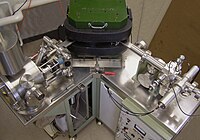
Photo from wikipedia
Compound-specific nitrogen stable isotope analysis provides an approach for estimating animal trophic position that may overcome key issues associated with stable isotope analysis of bulk tissue. Yet compound-specific trophic discrimination… Click to show full abstract
Compound-specific nitrogen stable isotope analysis provides an approach for estimating animal trophic position that may overcome key issues associated with stable isotope analysis of bulk tissue. Yet compound-specific trophic discrimination factors have not been estimated for a broad range of habitats, taxa, and diets. We conducted a controlled-feeding experiment to characterize the variation in compound-specific (TDFAA) and bulk (TDFBulk) trophic discrimination factors of four freshwater fish species fed on three distinct diets. We also compared TDFAA of fish muscle and scale to evaluate the viability of scales for making food web inferences. Mean ± 1 SD TDFBulk was 2.2‰ ± 0.9‰, and there were significant effects of species and diet trophic position on TDFBulk. Mean ± 1 SD TDFAA was 6.9‰ ± 0.8‰. Although there was no effect of species on TDFAA, there were significant differences in TDFAA across the three diets. TDFAA from fish scales were not significantly different from those of muscle. Our study illust...
Journal Title: Canadian Journal of Fisheries and Aquatic Sciences
Year Published: 2017
Link to full text (if available)
Share on Social Media: Sign Up to like & get
recommendations!